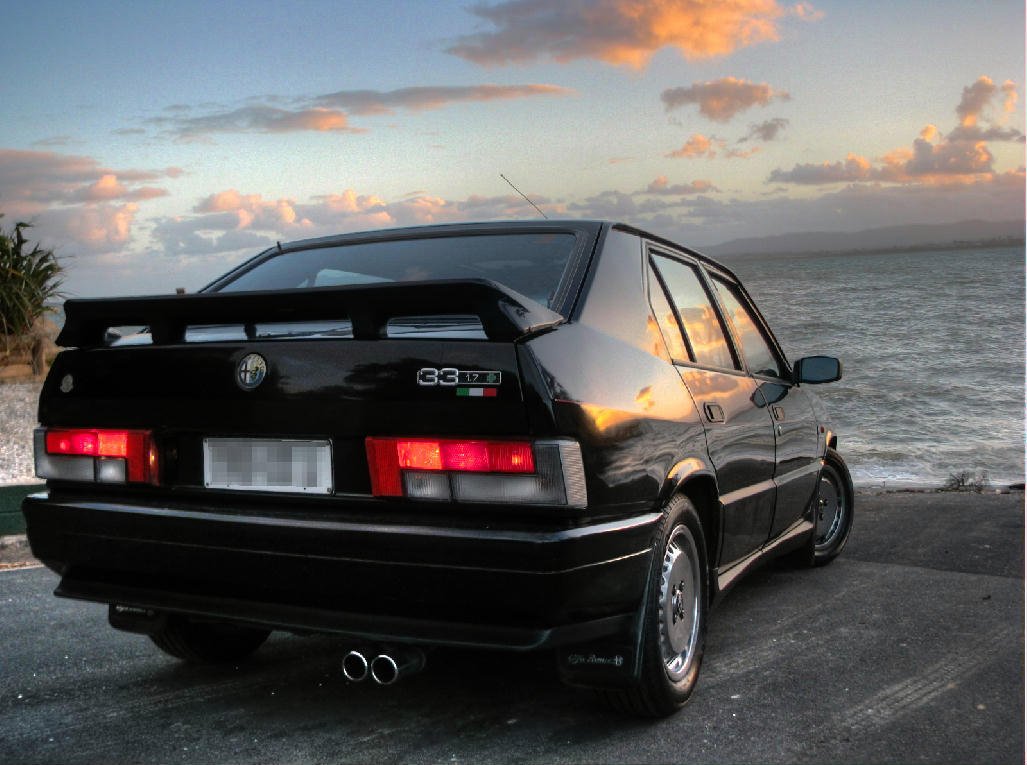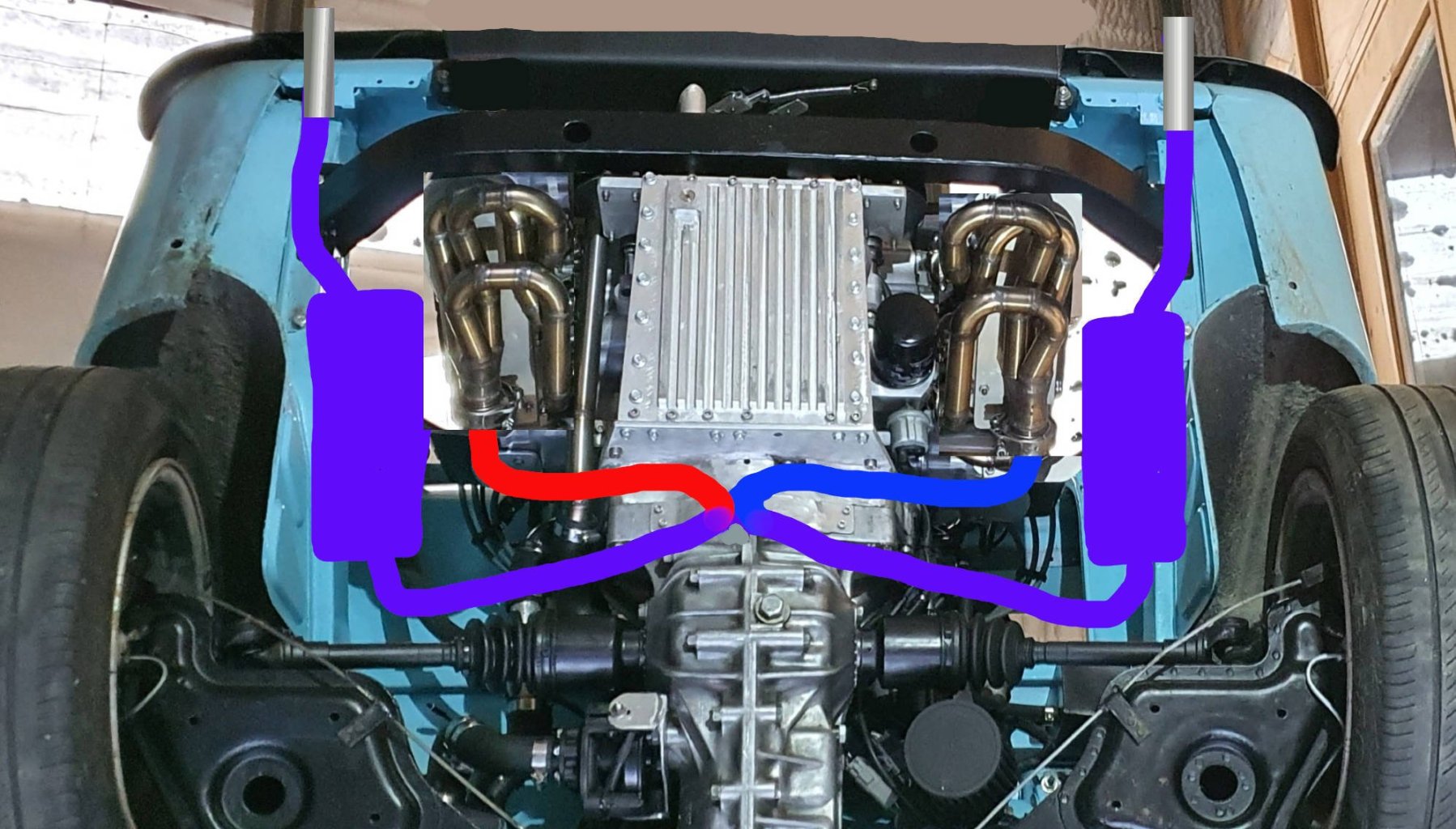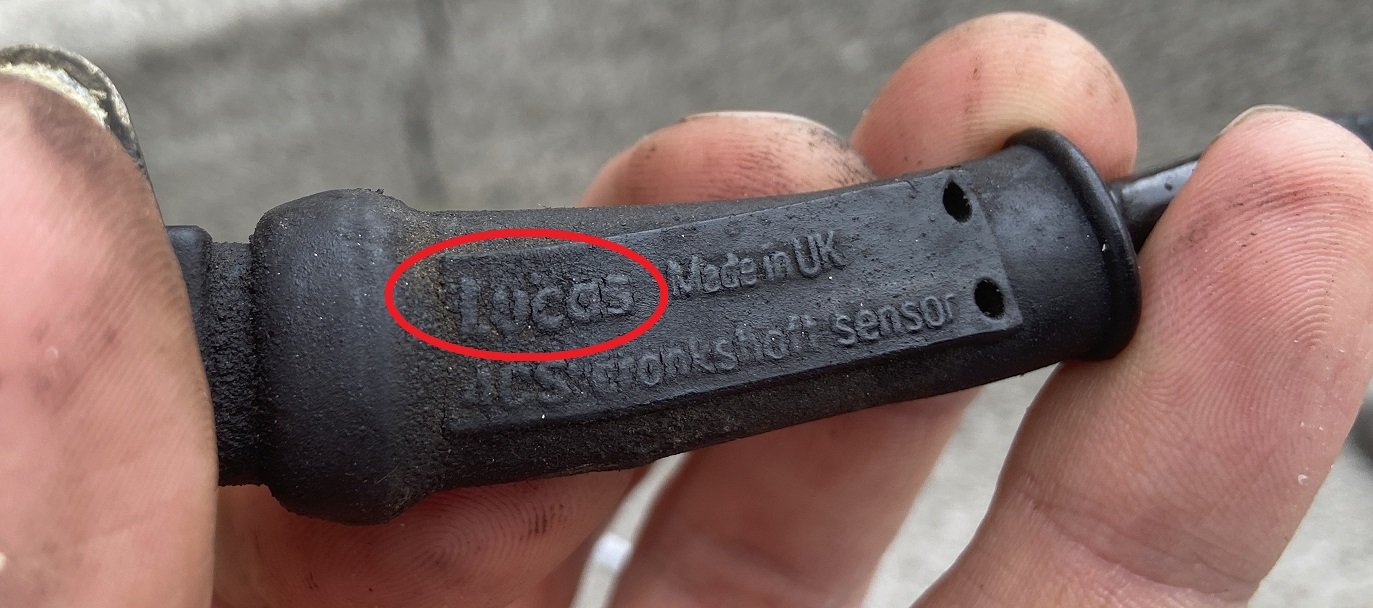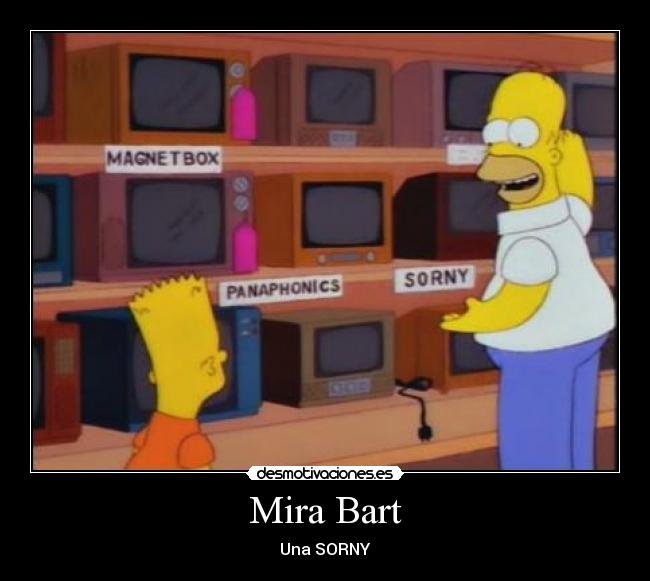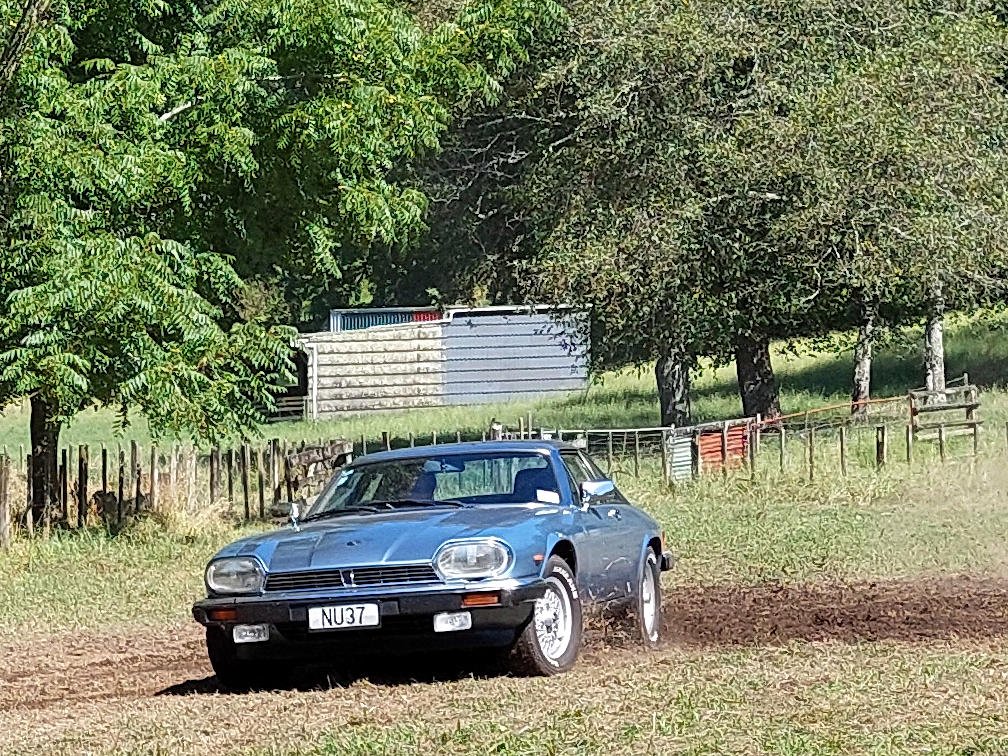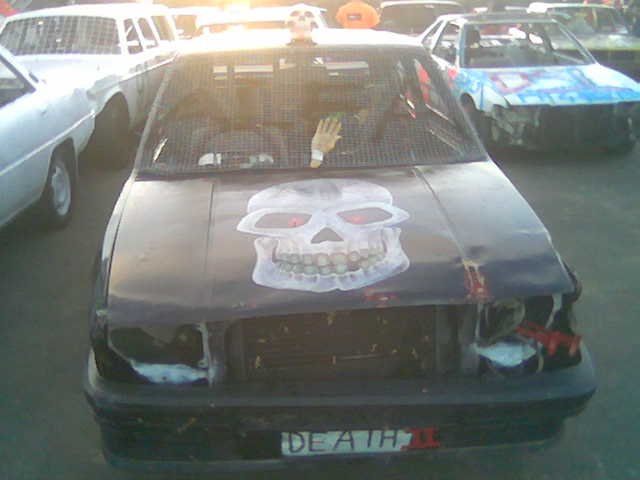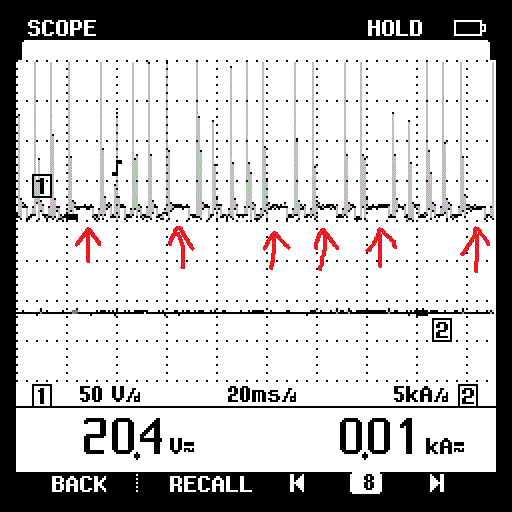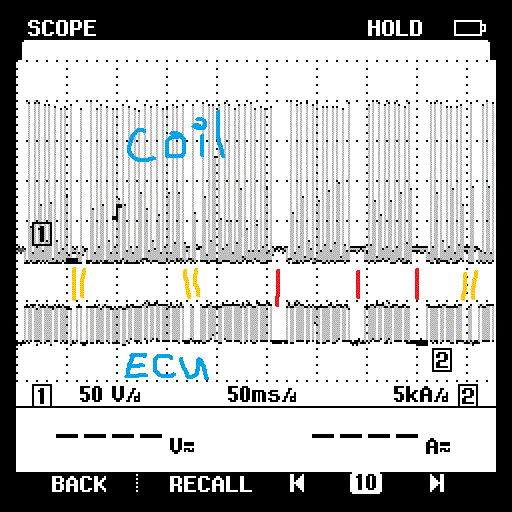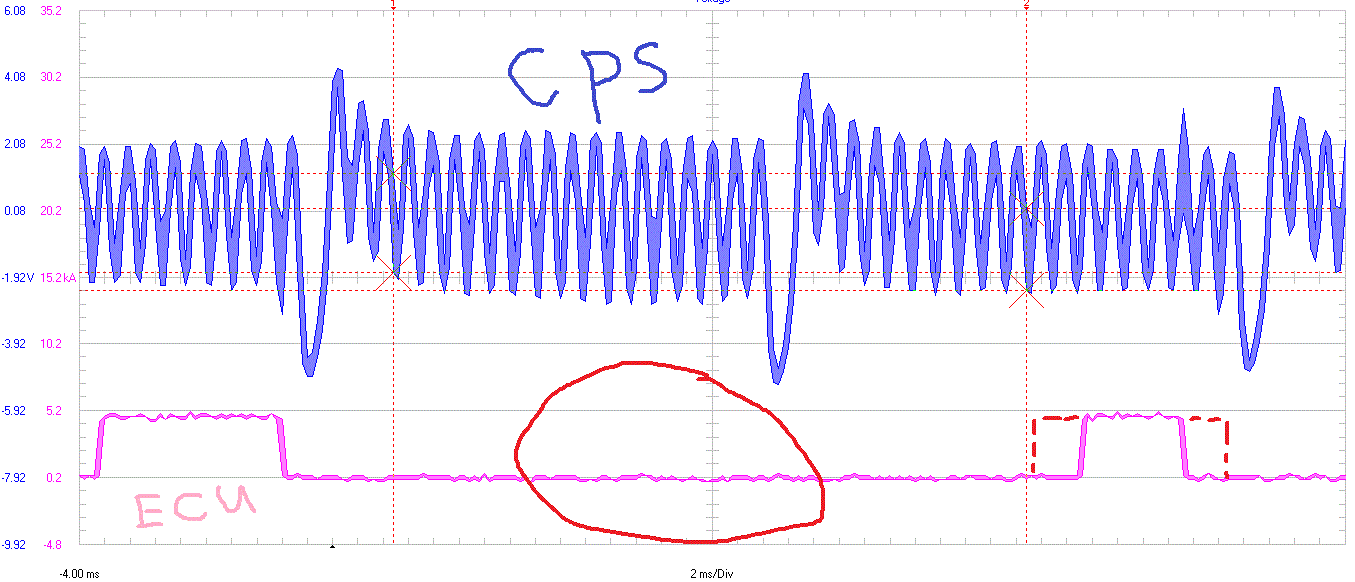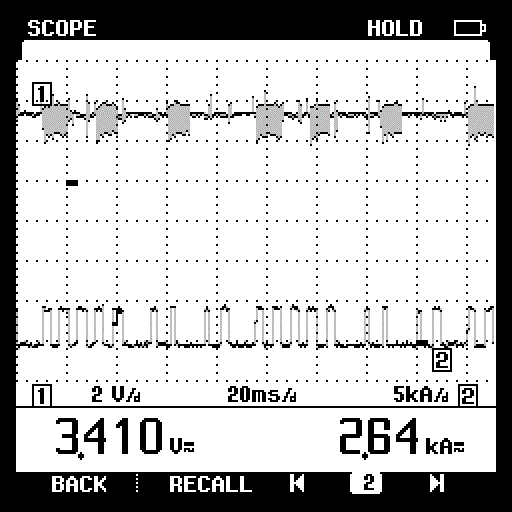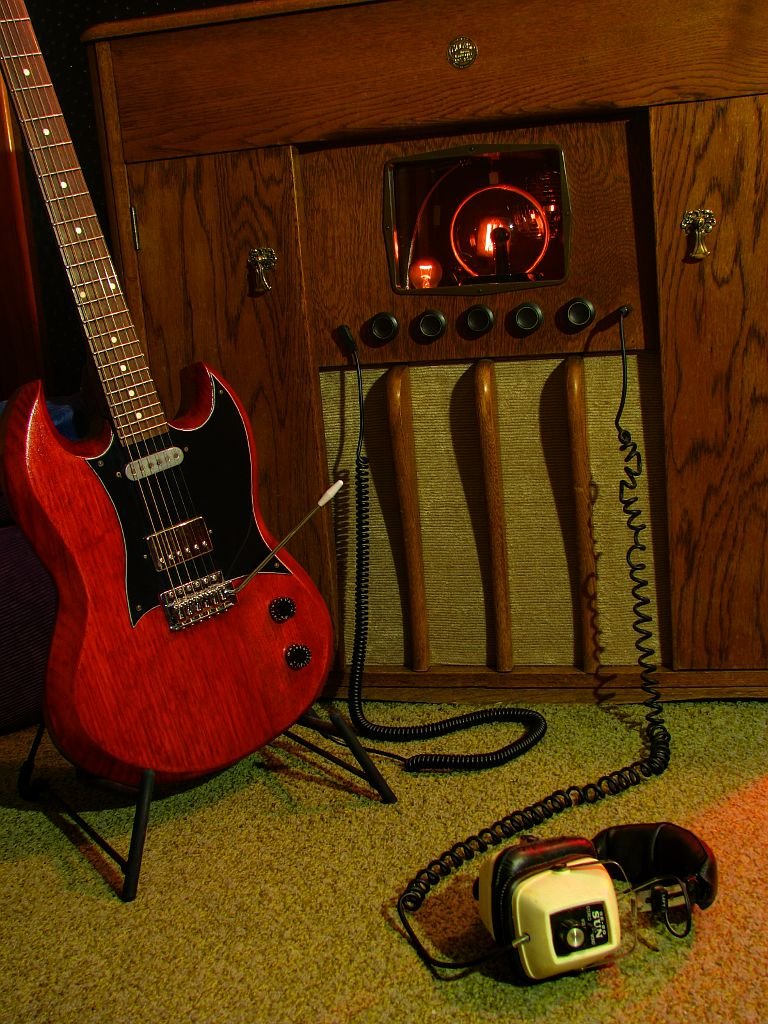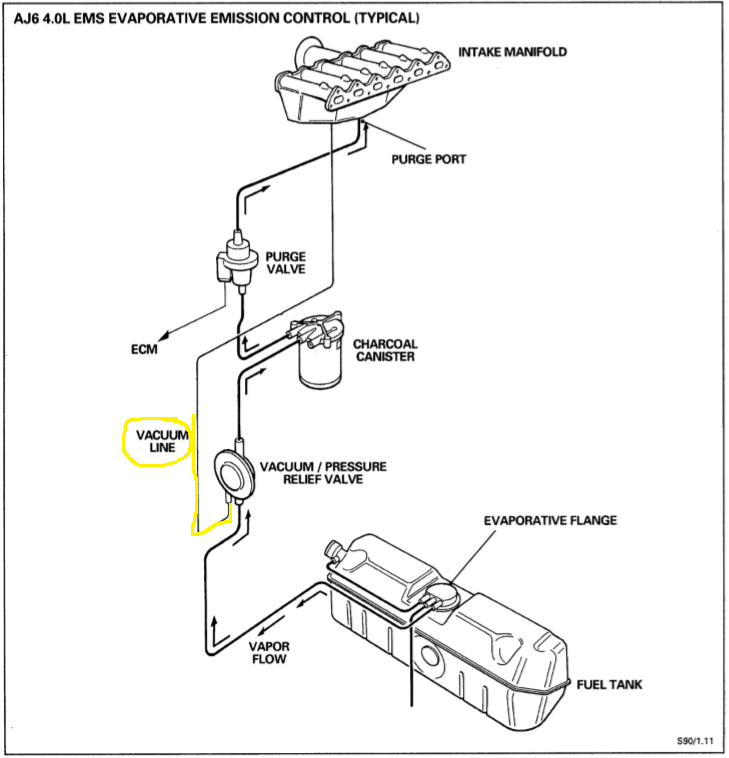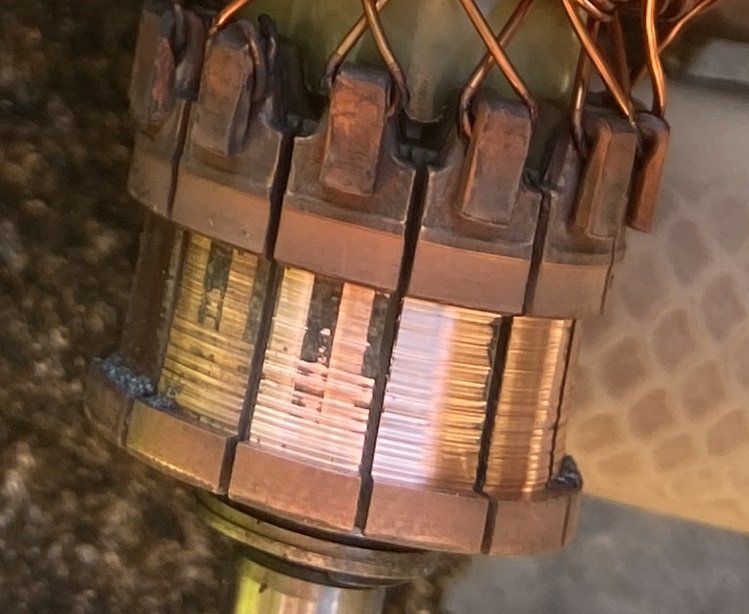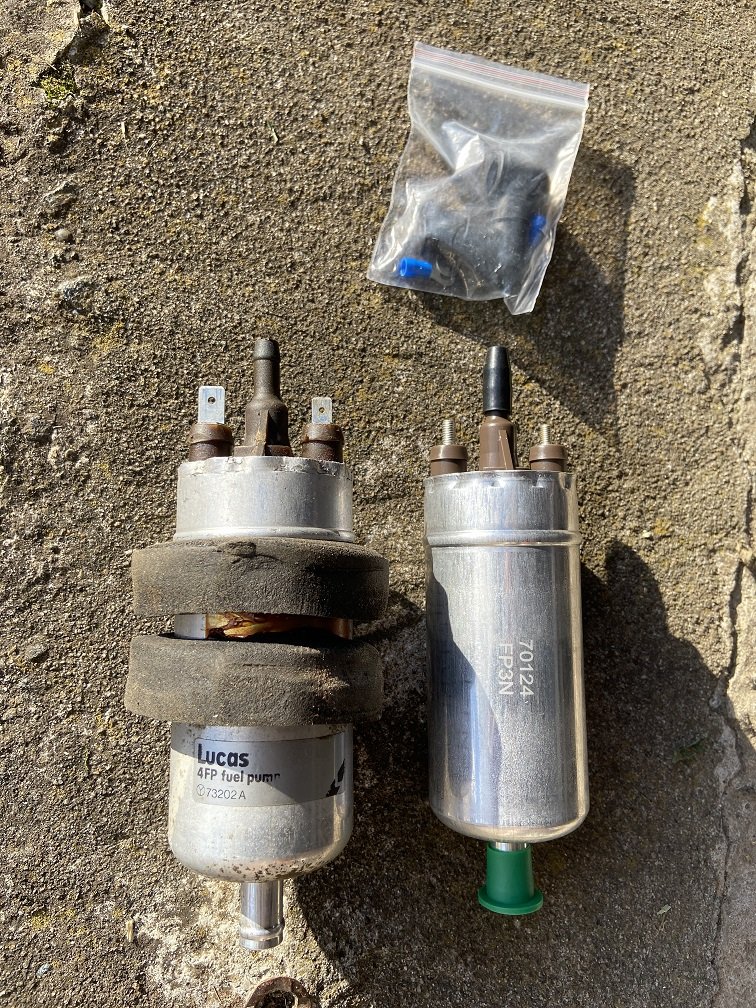-
Posts
2,030 -
Joined
-
Last visited
-
Days Won
3
Everything posted by Thousand Dollar Supercar
-
Datlows 67 Eldorado discussion
Thousand Dollar Supercar replied to datlow's topic in Project Discussion
Yeah, if Uncle Bob did start it recently after all, perhaps the engine is OK and the starter's just not working when in the car. Have you tried starting the car with the lights on? Lights dim when trying to crank engine = starter is drawing current = more likely that engine is seized. -
Maybe. I assume the pitch of an exhaust note would be a function of pipe diameter, which should be a function of engine displacement, assuming you want to keep the gas flow speeds high for good performance... but I suppose you could still put fat pipes on a small engine to make it sound deep like a Harley... in exchange for it performing like a Harley. Don't go for a cheap rolled tip like I used to have on my Alfa 33: The rolled ends of the tips were in the path of the exhaust and I think they were responsible for adding a wooshy turbulent air noise. This reminds me of oldschool Nats 2016, where someone brought a 911 to the track day and swapped on a manifold like that in the pits: I don't think I knew who those guys were, and I don't know whether I still have the original footage without music over it. Are these the stock headers from your generation of Goldwing engine? They don't look equal length, which might mean less of a smooth / clean straight 6 sound than you're currently getting?
-
Here's what you do: Swap the headers left and right - they'll bolt straight up and fit perfectly without fouling the crossmember (guaranteed), and the outlets will point forward Run new pipes from each header to partially merge in some sort of crossover x-pipe under the engine, but offset it slightly to one side (make the blue pipe and red pipe different lengths) to vary the amount of flat 6 vs straight 6 sound Put mufflers under both sides of the car alongside the engine, with exhaust outlets close enough to the ends of the bumper that the fumes get swept away Put some chrome tips on so it looks staunch as Alternatively, I see the classic Porsche single rear muffler was a hotdog shape / cylindrical with rounded ends, which must be for a reason.. Maybe you want to avoid large flat parallel surfaces where possible, to break up standing waves / reduce resonance / for strength? I definitely know what I'm talking about because of all the exhaust fabrication I do for a day job.
-
Fast forward six months and I've cracked the high-rpm misfire. transmission issue fuel issue (injector, pump, filter, pressure regulator) spark issue (plugs, leads, coil, ignition module) ECU issue (water damage, failing components) crankshaft position sensor / crank angle sensor I know I previously measured the crankshaft position sensor signal at the ECU and declared it OK, but I must have been... missing... something (har de har har ). The CPS pulses were almost too rapid for my scope to capture in much detail - they must have been deficient in some way that I couldn't see on the scope. Maybe they just had inadequate voltage at high revs. A random Barry on the internet concurs that Jag CPSs can give weird issues on the AJ6/AJ16 engines: You can't easily buy a new Lucas '4CS' CPS for the AJ6 engine for sensible money, so I bought one of these later versions for the revised AJ16 engine, cut the wires, swapped the plugs over and crossed my fingers. It works. The original sensor shall be inspected with a hammer, in retaliation for all that it has cost me in Uber rides, time off work, lost weekends, replacement parts that didn't need replacing etc. Now back to our regularly-scheduled programme - the impossible quest to make a Jaguar XJ-S into a good car. I decided to install the rocker cover gasket I bought when I was worried that oil leaking into the spark plug wells was causing misfires. The end snapped off the cam breather hose when I tried to detach the hose from the cam cover, so I guess the hose gets to be shorter now. Check out the mighty 24V DOHC valvetrain which gives the AJ6 the ability to rev all the way to 5750 or so.. Gasket changed. Next thing: Audio system upgrade. Before: Front 5.25" component speakers in the doors running off the head unit, tweeters mounted on the A-pillars Rear 6x9 speakers in the rear seat storage bin areas, also running off the head unit There was not enough bass. If I tried to fix that with EQ adjustments and the fade control (sending more sound to the larger rear speakers), it still didn't sound great and it caused distortion to kick in earlier / reduced my maximum volume. I had previously decided there wasn't enough room in the XJ-S interior to improve on this setup, but this time I was determined. After: 8" under-seat subwoofer under the front passenger seat Amp under the driver's seat Front speakers run off the amp Rear speakers still run off the head unit, because I need the ability to control them independently from the fronts and I had to devote the head unit's rear outputs to the sub How did I make it fit? The XJ-S seats are so close to the floor and the bases are so saggy that there's not much height underneath them, so the new sub has to sit directly on the floorpan (carpet and foam underlay removed): This sub was a brand new purchase, but the amp is an old beast from 2010 (Fast and Furious 4 / 5) that has been hanging around in my wardrobe since I sold my Rover SD-1. It was too long to fit under the seat lengthwise: I was determined to use it anyway, and Nats was literally the next day so there wasn't time to find anything else. It wouldn't quite fit widthwise / transversely, even upside down. I opened it up and found that its case engaged in a bit of crotch stuffing: Look at all that empty space in there, making the amp look so big that all your mates are impressed, even though the circuit board doesn't need that much room. What to do? You've heard of Panaphonics, Magnetbox and Sorny: I call this one 'Sawny'. I literally sawed the end off the Sony amp with a hacksaw, following the dotted lines a few photos above. Now I won't be able to sell it on Facebook Marketplace to buy weed... I covered the end with a metal panel sealed with thermal paste to offset the reduced heat dissipation of the cut-down case (yeah, probably not), and hey presto, it fits under the seat, job done: I pulled apart the car interior running all the necessary wires, and swapped in my better head unit, now with an improvised condensation deflector shield (see earlier post). I turned it all on and discovered that the last panelbeater to remove my front door cards hadn't reconnected the RF speaker afterwards. Sorted that. By the time I got the interior back together and convinced the car to run (I thought I'd blown something when swapping ECUs, but I'd just left the kill switch on ), it was after midnight on the first day of Nats. I couldn't wake the neighbours testing my new soundz, so I hit the highway. The radio picked a most appropriate 80s song to crank up in an XJ-S when cruising down a city motorway after midnight: Now that I've tested the new setup over Nats, it's a big step up, except for Sawny heating my seat after a while.
- 37 replies
-
- 27
-

-

-
There was an Odyssey in the derby last night. It managed to complete both jalopy races and come close to winning the derby, but something started burning underneath it. The derby was won by what looked like the remains of a Primera. The number of entrants in the derby was fairly low compared to what I've seen in the past - only around 25 cars. Maybe some of the entrants couldn't make the rescheduling, or there was less advertising, or it's already getting hard to find suitable cars. The racing was good though - a race leader blew an engine, there were a couple of rollovers etc, and they have a whole field of cars running the Buick V6. It sounded like a herd of cattle. Next event is the 1st of Jan, and it includes a fireworks display.
-
No, I was thinking that since aftermarket ECUs support O2 sensors, that would be a sensible addition for magical self-learning idle and fuel maps? I am not informed on this subject. This XJ-S is the only fuel-injected car I've ever owned. I bet an AJ6 would feel ready to explode at 6500rpm! I hear that AJ6s have plenty of limitations that keep them from even making their quoted power, and so they have no business doing such crazy engine speeds. "Fully rebuilt, balance & blueprinted engine with custom intake and Jenvey throttle bodies. Custom exhaust headers and system. Link engine management. Engine rebuild and setup carried out by Dyno Tuner Uk Ltd 351 BHP @ the Flywheel"
-
Yes, I’ve heard that the crank angle sensors on AJ6s are known for instantly and completely dying. I can’t see anything wrong with the signal from mine though. Its pulses get a bit rapid for my oscilloscope at higher rpm, but you can still see enough detail to be fairly confident it’s OK. If I end up going with an aftermarket ECU as Bigfoot suggests, perhaps that would be a good opportunity to fit an O2 sensor and to get a bit more power via advanced timing (a common AJ6 mod was to move the crank angle sensor because the ignition timing of the factory ECU is too conservative). Lots of work and lots of learning though. Stock ECU replacement sounds easier if I can get one.
-
The spark signal from the ECU to the ignition module deteriorates with engine speed and throttle angle. The engine still runs normally in normal driving, but the ignition problem seems to be creeping further down the rev range over time. I found a small amount of water seemed to have leaked into the ECU, and maybe that has done some damage, maybe not... The reason for involving the auto electrician is that I wanted to rule out what seemed to be electrical noise on the 12V supply / from the alternator. My oscilloscope seemed to show this noise being absent at idle but increasing as I got to the engine speeds where the misfire would begin, and I thought maybe the noise could be 'confusing' the otherwise-functional ECU. I hoped the auto sparky could tell me whether the noise was normal / could test the alternator safely without blowing its regulator or something. I told him not to hurry, as I'm back and forward from Australia for work at the moment. I haven't checked in on him lately.
-
My previous car was an Alfa Romeo, and the speedometer got progressively more intermittent due to a bad connection between parts of the instrument cluster. It took me years to discover that, because I had figured out a temporary solution to kick-start the speedo using a seemingly unrelated button on the dash.
-
I actually discussed with the fuel injection guys the fact that my Jag's ECU predates OBD1. It has a circular serial connector which you could presumably connect to your BBC Microcomputer, but once you loaded the Jaguar software from floppy disk, it would probably tell you nothing is wrong. My version of the Advanced Jaguar Six engine wasn't advanced enough to have an exhaust gas oxygen sensor for feedback, so its ECU presumably believes it's sending perfectly good pulses to the injectors and coil and everything is fine. Edit: Also, when I went to the European car specialist, they said they didn't work on these cars much any more. I could hear the fear in the guy's voice when he asked if it was a V12, and I got the impression I'd have been turned away immediately if I'd answered 'yes'. There's now only one guy left in Auckland who hates himself enough to work on classic Jags for a living, and last time I checked, he had a 3-month waiting list.
-
Let's not forget that I put the Jag into the wall AND the barrier because I'm Leadfoot Larry. It will only ever be a driver-grade example now, if it even survives my ownership at all. That makes it OK that I took it on grass skids at the last Nats. That's actually R121 - the prefix is under the heatsink. It might be responsible for some of the rusty stuff, so I guess I should change it too. The way that there was a delay before the misfire would kick in at medium rpm makes it seem like the ECU is limited in the amount of power it can draw without overheating/draining/collapsing something. If it has to generate pulses too rapidly, it soon starts to drop some (one, two, miss a few, ninety-nine, one hundred!), but gentle driving is fine. I hope this is just down to a few off-the-shelf discrete components and/or dirty connections, so it's an easy fix.
-
I tried taking the Jag to fuel injection specialists, and they told me the misfire wasn't caused by the fuel injection. Next I took it to a European car specialist recommended by the fuel injection place, but they told me they couldn't replicate the fault. This was a lie, because the fault was plain as day as I drove home. It had become bad enough that I could get a mild misfire from moderate throttle at moderate rpm. If I stomped the throttle to make the auto kick down, there was no acceleration to be had, but instead you get awesome machine gun fire / spitting and popping from the exhausts. I had been hoping to fix this by getting some bloke in, but it was increasingly looking like I'd have to do it myself. So I hooked up an old oscilloscope to measure the +12V side of the ignition coil. I ran wires from the engine bay in through the window, so I could have the scope sitting next to me to allow me to hit the HOLD button while the car was acting up. What did I find? Absent sparks. Once you invoke the misfire, the coil isn't being switched consistently. Maybe it's the ignition module? So I uncovered the ECU in the passenger footwell and jammed another oscilloscope probe into the back of an ECU plug to measure the signal going to the ignition module. Now we can compare the ignition coil behaviour to the ignition signal from the ECU. They line up exactly, i.e. the Lucas 'Heart of Darkness' ECU is telling the car to misfire. You can see a bunch of smaller and bigger gaps in the ECU's spark signal corresponding to the coil not being switched by the ignition module. Why would the ECU fail to fire the spark plugs (besides the whole Lucas thing)? Maybe some other input to the ECU was confusing it. So I isolated the crankshaft position sensor signal at the ECU, and plotted it together with the spark signal. I bet you didn't know I was so technical. Anyway, the crank position signal seems consistent, but despite that, some of the ECU's pulses to the ignition module are still missing or they are of a short duration (compare the one on the right to the one on the left). I also compared the throttle position sensor and the airflow meter load signal against the ECU's ignition pulses. I couldn't see anything wrong with those inputs except that they seem quite noisy once the engine's working hard. I can't remember whether the #1 signal in the screenshot above is TPS or AFM, but they both look the same and both develop those random blocks of noise, which are barely visible when the engine's not under load. The #2 signal in the screenshot is the erratic ECU ignition pulses. So I was scratching my head when my Smell of Success fragrance bottle decided to fragrance the ECU plug (don't ask) and stall the car. This caused me to take a closer look at the ECU and discover that some of its connections were a bit corroded. I took it out of the car completely, opened it up and dared to gaze into the heart of darkness... Com pew pew pew, com-pu, computer games.. ENHANCE! Doh! So my plan is to clean that up, test/replace that corroded diode, replace all of the capacitors which I can identify, put it back together and try again. If it works, another condensation deflector shield might be a good idea.
- 37 replies
-
- 42
-

-

-
BlownCorona Builds a Stingray
Thousand Dollar Supercar replied to BlownCorona's topic in Other Projects
My brother made this guitar using an existing neck: He put the bridge too far out of position, which meant that even when the open strings were tuned to the correct pitch, the notes produced by fretting the strings would be sharp or flat (can't remember which). Also, something else was not quite right about the bridge mounting which would result in the tuning being thrown out if you used the whammy bar. Finally, the mounting of the neck to the body left a bit to be desired. His subsequent attempts have been more successful, and I think he has built a bass as well. Good luck, this should be an interesting project. -
Official Mitsi weirdo buys another weird Mitsubishi
Thousand Dollar Supercar replied to fuel's topic in Other Projects
So I'm currently back in a Mitsubishi for the first time in over 20 years. @fuel's wagon was facing eviction from @OSM Garage's work, so now it's hanging around my place making itself useful while my Jag is in the shop. I'm temporarily an all-Japanese-car household. Not only is the wagon now on Evo mags, the manual conversion has been done. It's a proper Diamante 30Rse now, not a 30ARse. It still has the stock exhaust, which is a shame because nobody can hear the V6 manual sounds. I will be parking this car out in the elements (since it's Japanese, you can do that) and probably barely giving it enough use. It would appreciate a better home, so if you have room in your heart to adopt a Mitsubishi and become an honorary Mitsi weirdo, get in touch with @fuel. -
I changed the ignition coil to see if it had any effect. The one which was in the car looks to have been made in 1995. If it is a Lucas DLB198 coil as suggested by its mounting bracket, its secondary resistance was measuring below spec. The new coil is branded "Flame-Thrower", which sold me on it immediately. This should be its theme song. Anyway, it didn't make any difference. The car's intermittent stumbling idle remains, and its misfiring near peak power seems to be getting worse. I read a bunch of forum threads of other people who have tried to crack the bad idle problem with their AJ6 or AJ16 (the revised version of the same motor), and most people seem to test and change a bunch of stuff then give up (the threads just stop). I did find one thread where someone actually fixed it, and the problem in that case turned out to be several exhaust valves which weren't sealing well. The guy took the head off and got the valves reseated or reground or whatever, and then the car idled properly. So.... I wonder if I could have some partially burnt valves or weak valve springs or worn cam lobes or something. I did another compression test today and got similar slightly-too-high readings (190, 183, 190, 180, 188 and 190psi) to the last compression test. Might be my gauge. The spark plugs looked fine. I gapped them down to factory spec, no improvement. I have recently acquired a detailed factory document all about the engine management on the later 4.0 AJ6 which gained oxygen sensors (so many variants of this motor, grrr). The guide has taught me that my fuel tank vacuum pressure relief valve has no vacuum line connected to it: I don't know why there would be a valve if there's no vacuum line for it. Maybe it's for other markets / I hope the vacuum line isn't sitting somewhere disconnected and leaking air. This new guide has given me a thousand things to check. For example, the ECU controls ignition timing and fuel mixture based on airflow and crank position, with a compensation factor for throttle position and coolant temp and air temp, and now I have a bunch of expected voltages and resistances and oscilloscope waveforms for all of this. I just need the motivation to spend weekends chasing my tail.
- 37 replies
-
- 14
-

-

-
I guess I could put it in my driveway if you don’t find a better offer by the deadline. I’m over the hill from Onehunga in Mount Roskill not far from the Hillsborough offramp. My drive is uncovered, and the birds poo on clean or dark-coloured cars if I forget and park under the power lines. A wagon would be more sensible than an XJS for transporting my keyboard to band practice.
-
The pump gets a continuous supply of whatever voltage the alternator's putting out (square #35 in the diagram below connects to the battery). The supply is switched via a relay controlled by the ECU, therefore supply would be either on or off (not variable). Even if the alternator drive belt decided to slip at high rpm, the pump would receive a minimum of the battery voltage minus some losses. If the supply is 'iffy' as in too low, it must be magically reducing (but not switching off) through unknown means, and only at high rpm I've previously measured the voltage at the pump terminals to be around 13V at idle. If the supply is iffy as in too high, I don't think I'd have a fuel starvation / rev limiter effect at full power Although I don't think I'd find anything, I could connect a meter to the pump's terminals, set it to min/max logging mode, and then go and do some pulls. I really doubt that's the problem though. I believe that my XJ-S has an open-loop fuel injection system with no oxygen sensor. It probably makes assumptions about the fuel pressure and fires the injectors based on the airflow meter or throttle position or something. This would mean that it has no clue that anything's going wrong. It couldn't make any adjustment in response to low fuel pressure / lean mixtures, let alone log some kind of fault code once the injectors reach 100% duty cycle. It would just idle poorly and shrug, suddenly lose power at full noise and shrug...
-
After running fine during Nats, the Jag has started doing its fuel-starvation-at-full-power thing again. @h4nd had already pointed out that the commutator in my fuel pump had looked pretty worn. Here it is at 100% scale in the only photo which I hadn't already resized to low res: Looks like it has done 36 years of service. I guess all that missing copper was caught by the old fuel filter and isn't still inside my fuel system somewhere.. I bought a new fuel pump, which is supposedly for the XJS though it's slightly smaller and has a different style of terminal: Annoyingly, nothing changed! The problem is still present with the new fuel pump installed. This probably means that the old pump was never the cause in the first place, even before I performed the mod to stop its impeller housing spinning. I'm still working under the assumption that the problem is caused by fuel starvation rather than by ignition, because surely if the coil was too weak to provide enough sparks at high rpm, there would be all kinds of backfires from the unburned fuel? My old Alfa would cut the spark to limit engine rpm, and when I hit that limiter too aggressively, it would just about blow the muffler apart. I guess I could have a partial blockage anywhere between the pump and the injectors, or a problem with the fuel pressure regulator (which is controlled by manifold vacuum), or maybe the ECU is actually bringing in a rev limiter when it shouldn't.. I think I've noticed the rev counter spaz in the downward direction in response to the problem occurring, but generally you want to keep your eyes on the road when nearing redline, and you instinctively back off instantly if the engine starts doing strange stuff. I still have the other issue of the engine not running smoothly at idle and low rpm - when you're under the bonnet you can detect an intermittent shaking of the motor like a partial misfire, up until the point where the rpms are high enough to mask it. I don't know how to proceed with the diagnosis. Any ideas? Might have to take it to somebody who can actually measure stuff (exhaust CO, fuel pressure, injector duty cycle or whatever)?
- 37 replies
-
- 8
-



